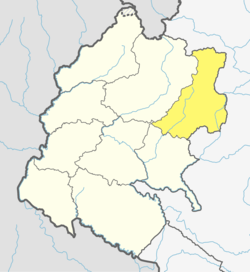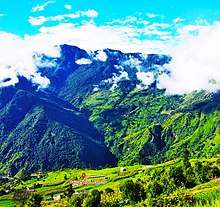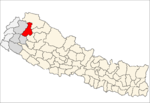Bajura District
Bajura District (Nepali: बाजुरा जिल्ला ![]()
Bajura District बाजुरा | |
|---|---|
District | |
 Location of Bajura District | |
| Coordinates: 29°26′49″N 81°29′12″E | |
| Country | |
| Province | Sudurpashchim Pradesh |
| Admin HQ. | Martadi (today part of Badimalika municipality) |
| Government | |
| • Type | Coordination committee |
| • Body | DCC, Bajura |
| Area | |
| • Total | 2,188 km2 (845 sq mi) |
| Elevation | 6,400 m (21,000 ft) |
| Population (2011)[1] | |
| • Total | 134,912 |
| • Density | 62/km2 (160/sq mi) |
| Time zone | UTC+05:45 (NPT) |
| Postal Codes | 10600 |
| Telephone Code | 097 |
| Main Language(s) | Nepali |
| Website | www |
Geography and Climate
| Climate Zone[3] | Elevation Range | % of Area |
|---|---|---|
| Upper Tropical | 300 to 1,000 meters 1,000 to 3,300 ft. |
0.6% |
| Subtropical | 1,000 to 2,000 meters 3,300 to 6,600 ft. |
19.7% |
| Temperate | 2,000 to 3,000 meters 6,400 to 9,800 ft. |
36.4% |
| Subalpine | 3,000 to 4,000 meters 9,800 to 13,100 ft. |
25.2% |
| Alpine | 4,000 to 5,000 meters 13,100 to 16,400 ft. |
11.2% |
| Nival | above 5,000 meters | 6.4% |
| Trans-Himalayan | 3,000 to 6,400 meters 9,800 to 21,000 ft. |
0.5% |
Demographics
At the time of the 2011 Nepal census, Bajura District had a population of 134,912. Of these, 99.0% spoke Nepali and 0.5% Sherpa as their first language.[4]
Administration
The district consists of nine municipalities, out of which four are urban municipalities and five are rural municipalities. These are as follows:[5]
- Badimalika Municipality
- Triveni Municipality
- Budhiganga Municipality
- Budhinanda Municipality
- Gaumul Rural Municipality
- Jagnnath Rural Municipality
- Swamikartik Khapar Rural Municipality
- Chhededaha Rural Municipality
- Himali Rural Municipality
Former Village Development Committees
Prior to the restructuring of the district, Bajura District consisted of the following Village development committees:

- Atichaur
- Baddhu
- Barhabise
- Bichhiya
- Bramhatola
- Budhiganga
- Chhatara
- Dahakot
- Dogadi
- Gotri
- Gudukhati
- Jagannath
- Jayabageshwari
- Jugada
- Kailashmandau
- Kanda
- Kolti
- Kotila
- Kuldeumadau
- Manakot
- Martadi
- Pandusain
- Rugin
- Sappata
- Tolidewal
- Wai
- Jukot
Health care
The small health centers in many VDCs are without Auxiliary Health Workers (AHWs), Auxiliary Nurse Midwives (ANMs) and Community Health Workers (CHWs). Primary or normal treatment can be done in the district headquarters and also in Bayalpata Hospital of neighbouring district Accham while people seeking severe case have to travel a long distance to Kathmandu or other major cities or end up dying because of lack of treatment. Many people still believe in Dhami and Jhakri and do not always seek medicine or go to the hospital for the treatment. An NGO, PHASE Nepal provides many health care facilities and training programs to six VDCs: Kolti, Wai, Kotila, Pandusain, Rugin and Baddhu. Many people residing in these VDCs have benefited from the program.[6]
Currently PHASE Nepal is working on several projects in this district including community health and education, livelihood, hygiene, sanitation and diarrhoea mitigation programmes.
Colleges and School in Bajura
Martadi, Bajura
- Bajura Multiple Campus
It has been conditioning the bachelor level programs with affiliation to Tribhuwan University, Kirtipur, Kathmandu, Nepal.
- Badimalika English Boarding School
- Converse Academy
- Shree Malika Higher Secondary School
Kolti, Bajura
- Shree Jana Prakash Higher Secondary School
Naubis, Bajura
- Shree Bhanodaya higher Secondary School
- Badimalika Multiple Campus
It is conducting the Bachelor's level program BBS, BEd & B.A. with affiliation to Tribhuwan University
Triveni, Bajura
- Ratna Higher Secondary School, Seliphal, Bajura.
It was established in 2022 BS, it recently started offering +2 level program in Humanities and Education stream.
- Masteshwori Higher Secondary School, Pandhara, Bajura.
The school is providing plus two level program in Humanities and Education stream.
- Tolidewal Danda Secondary School, Toli, Bajura.
The school is providing plus two level program in Humanities and Education stream.

- Tribhuwaneshwari Secondary School, Chhatara, Bajura.
The school is providing plus two level program in Management and Education stream.
- Shree Parvati Secondary School, Paima, Bajura
- Nateshwori Secondary School, Khripata, Bajura
- Damtha Secondary School, Kailashmandu Bajura
- Bajura Model Academy, Khirpata Bajura
It is an English Medium School providing primary level education.

Photos of Bajura
 View of Army Camp
View of Army Camp view of Martadi from Khapalta
view of Martadi from Khapalta view of mountain from Martadi Bajar
view of mountain from Martadi Bajar Badi Malika Temple & Patan Pooja
Badi Malika Temple & Patan Pooja Triveni, Holy river visited before Badimalika
Triveni, Holy river visited before Badimalika
File:
References
- "National Population and Housing Census 2011(National Report)" (PDF). Central Bureau of Statistics. Government of Nepal. November 2012. Archived from the original (PDF) on 18 April 2013. Retrieved November 2012. Check date values in:
|accessdate=(help) - "Nepal Census 2001". Nepal's Village Development Committees. Digital Himalaya. Archived from the original on 12 October 2008. Retrieved 12 December 2008.
- The Map of Potential Vegetation of Nepal – a forestry/agroecological/biodiversity classification system (PDF), . Forest & Landscape Development and Environment Series 2-2005 and CFC-TIS Document Series No.110., 2005, ISBN 87-7903-210-9, retrieved 22 November 2013
- 2011 Nepal Census, Social Characteristics Tables
- "स्थानिय तह" (in Nepali). Ministry of Federal Affairs and General Administration. Archived from the original on 31 August 2018. Retrieved 1 September 2018.
- "Project Area: Bajura". PHASE Nepal.
External links
- "Districts of Nepal". Statoids.
| Wikimedia Commons has media related to Bajura District. |
